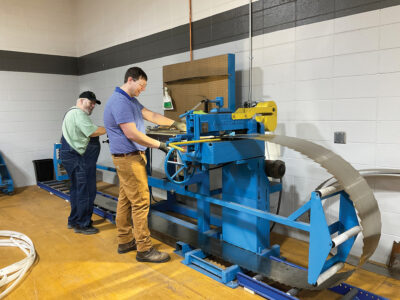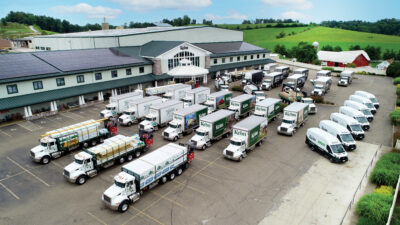Ontario/Quebec Business Trends

Headwinds Ahead For Ontario/Quebec
Richard Lipman
It seems like heading into fall there were several big picture issues and developments affecting the Quebec and Ontario markets. The U.S. Administration announced new section 232 tariffs on a range of Canadian wood products, citing national security concerns. These tariffs are applied in addition to existing anti-dumping (AD) and countervailing duties (CVD). For softwood timber and lumber, a new 10 percent tariff will apply to a wide range of softwood timber and lumber products, including logs, railway ties, and sawn timber under HTS codes 4403, 4406, and 4407. This measure directly affects standard Canadian softwood lumber exports (e.g. SPF), which will face a stacked tariff burden when entering the U.S. market, which began mid-October.
The average 2×4 eastern SPF price is listed at $580 (Cdn) by Natural Resources Canada and the average price has hovered in this area for the last 4 weeks, at $586. The 52-week average price is listed as $643 (Cdn). Mused an Ontario manufacturer, “The total duty is now more than 45 percent. We have gone from 15 percent in July, 35 percent to begin in August and now we are at 45 percent. Tariff and related costs have essentially tripled in a very short period and that makes it very tough to adjust to a new market scenario like this.”
It is because of the increasing duties and the current tough market conditions that Domtar is suspending their sawmill operations in Maniwaki, QC indefinitely. Noted a Quebec wholesaler, “Domtar only just started back up with operations in June following a previous shutdown from late 2024. It sounds like 60 to 80 employees have been working since they started up again. This will hurt the local economy for sure, where there are not a lot of other job prospects for workers. The forest industry in the region as a whole will be impacted.”
It was mentioned by a Quebec producer that “there is certainly again blame here on the provincial forest management system as being one of the culprits for this shut down.” This mill, that was purchased from Resolute Forest Products in 2023, supplies both Canada and export markets, the U.S. and overseas.
Ontario’s forest industry, too, has it challenges. Mills in Kapuskasing, Hearst and Cochrane, owned by GreenFirst Forest Products, are being scaled back, which began in early October. The company noted that this will last at least a week, but depending on market and supply conditions, the situation will be reassessed. Some 140 employees will be impacted. The company’s main customer for wood by-products, Kap Paper, announced it would idle its Kapuskasing paper mill.
Canada and the U.S. both depend on a healthy integrated forest sector supply chain.
The sawmill needs that location to take its chips and biomass, which can’t be absorbed by the other two remaining paper mills in the province. Said the company CEO “we are doing everything possible to protect our operations, support our employees and work with governments to find viable solutions.”
There are implications for others when curtailments like this happen. There have been four mill closures in the past two years and the difficulties sawmills have to sell their by-products. At the same time, the lumber trade continues to be squeezed by high U.S. tariffs, weak markets and persistently low prices. Like in Quebec, closures like this put pressure on the northern communities that are dependent on the forest industry.
The Ontario Forest Industries Association (OFIA) have stated that they are “very concerned about the impacts on these communities, the integrated sector and the regional economy of Northeastern Ontario. The global paper sector continues to evolve and Ontario is not immune to these forces. We strongly urge the Province of Ontario and the Government of Canada to explore all options and create a sustainable path forward for the Kapuskasing facility. In addition to a combined 45 percent duty and tariff rate on lumber exports and weak homebuilding demand, Ontario sawmillers are significantly challenged by the continual decline in pulpwood and residuals markets due to the closure and curtailments of four pulp and paper mills in the last two years.”
According to an Ontario wholesaler, “Many industry reps felt it was good that the Canadian government was going back to discuss trade with the U.S. Administration. Canada has made an effort and shown a willingness that we are ready to negotiate in good faith. We have gotten rid of counter tariffs.”
A Quebec wholesaler remarked that “it is hard to believe that Europe has better access to the U.S. than Canada. Looking for other markets takes time, it does not happen overnight, so things are challenging.”
Following the most recent round of Canada-U.S. trade talks, however, the Forest Products Association of Canada (FPAC), speaking for the nation’s forest sector, expressed it was disappointed in the recent discussions in Washington that concluded without relief for 232-affected sectors, including lumber, as the long-standing Softwood Lumber dispute and recently applied tariffs on Canada’s wood manufacturing industry continue to put operations and jobs at risk across the country.
FPAC recognizes that the talks were described as substantive and appreciates that negotiations are complex, but after eight years of escalating duties on softwood lumber, the lack of tangible progress for forest sector workers and communities is deeply concerning. They say that with more than 200,000 direct jobs and hundreds of towns and cities across Canada depending on a vibrant forest sector, lumber and forest products must be treated as a greater priority in Canada-U.S. trade discussions. The forest industry continues to face unjustified duties and tariffs that harm forestry workers here at home and raise costs for American families building and renovating their homes. FPAC is urging the government to ensure that lumber and forest products are clearly on the agenda as talks continue.
“We want to see more progress for our fellow Canadians working in sectors hard hit by U.S. tariffs, but we also want to see more public recognition from our federal government that our sector’s 200,000 employees are also a priority in these talks,” said the President and CEO of FPAC Canada. Canada and the U.S. both depend on a healthy integrated forest sector supply chain – one that supports good jobs here at home and helps build millions of desperately needed affordable housing units across both countries. We simply want to see more urgency and frankly we were left wanting more in the post-meeting reports coming out of (the most recent) discussions.”
One Ontario wholesaler noted that “now the U.S. is also adding tariffs to hit upholstered wooden furniture, cabinets and vanities, with 25 percent tariffs which are coming on in mid-October. The tariff amounts will increase again in January. Kitchens and furniture are strong industries in eastern Canada, that have flown under the tariff and duty radar for a long time, but now other wood products are being targeted. This will certainly hurt those industries too.”
The Province of Ontario just announced that they will provide an additional $30 million into its forestry sector to protect jobs, sustain northern communities and help sawmills adapt to shifting markets in the face of U.S. trade, duties and tariff threats. The province said the investment will build and maintain forest access roads and provide targeted support to sawmills, as they seek new and alternative markets for wood chips. This should provide some immediate relief, while positioning sawmills for longer-term growth.
The funding announcement is considered part of a broader strategy to make Ontario’s forestry sector more competitive and resilient, while calling on the federal government to match provincial commitments. The OFIA noted “the complete suite of measures being announced (recently by the province) demonstrates the continued commitment by….the entire Government of Ontario to protect Ontario’s advanced forest products sector. The Forest Access Roads Funding Program has been an incredibly successful public-private partnership.”
OFIA noted their analysis shows that for every public dollar invested in this program, the forest sectors invest three.









